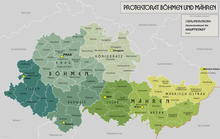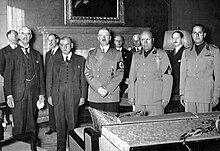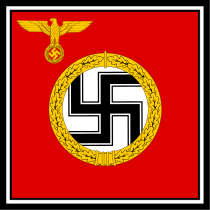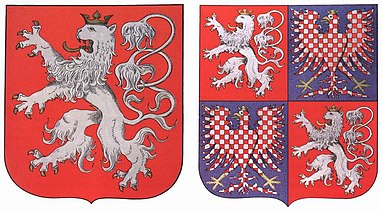User:Katharinaiv/Werkstatt
Dies ist das Vestibül zu meinen Werkstätten: --Katharinaiv (talk) 12:50, 17 August 2016 (UTC)
 Werkstatt 1 |
 Werkstatt 2 |
 Werkstatt 3 |
Zu bearbeitender Textː






-
Flag of the Protextortate Bohemia and Moravia
-
2=1943-12-07), published in the RMBl 1944 S. 2 (RMBi = "Reichsministerialblatt der inneren Verwaltung")
-
Official flag of the representative of the German Wehrmacht in Bohemia and Moravia, 1939-1941 (ratio 3:5), and 1942-1945 (ratio 14:19)
-
Lesser and greater coats of arms of the "Protectorate Bohemia and Moravia
-
Emblem of the Army of the Protectorate
- The Nazi-protetorate Bohemia and Moravia existred from 15th of March, 1939 until to the 08th of My, 1945.
- Initially could be used the stamps of the state Czechosklovensko until . After were only still valid stamps of the government of the protectorate and stamps of the German „Reichsgebiet“ insofar issued by official offices which were authorized for a such. Finally were all stamps of the Nazi-Empire officially valid until to the {{other date|2=1945-05-16) according to an ordinance of the Czechoslovakian authorities.
Viking art on stamps[edit]
The term "Viking art" describes the universe of creative artworks originated in Scandinavia and regions with occupations by the Vikings in Central Europe, England, Italy, Spain, France, North Africa), but also the predecessor art of the Kievan and Nowgorod Rus along the river Volga and other West-Russian rivers to the Byzantine Empire (it has given a "Imperial Guard of Varagian" in Byzantium as Viking freelancers with own culture and as such also with own creative artworks). Originally is a "Viking" a Scandinavian "Sea Warrior". Chronological, the term "Viking art" consist artworks created in the time from the first warlike encounters between Germanian peoples and the Roman Empire in 113 B.C. until to the end of Viking Era after the Battle of Stamford Bridge in 1066 A.D.. The most crucial events relating to this era were for instance:
- - single Germanian tribes migrated from Scandinavia to areas at the borders of the Roman Empire. (migration of Cimbers, Teutons, and Ambrons from Denmark to South); in Austria a first battle with Roman military units in 113 B.C.;
- - foundation of Switzerland, the Kievan Rus, and the Novgorod Rus by Swedish Vikings
- - appearance of Vikings in Mediterranean regions in the 450s and 460s A.D., capture and pillage of Rome in 465 A.D., no co-working with other Germanic tribes in the there areas
- - defeat of the Vikings by the Franks under Clovis I in 507 A.D.
- - foundation of Iceland as state in 999 A.D.
- - assault and pillage of the Christian Lindisfarne monstery (Ireland) in 793 A.D.
- - Viking invasion on the Faeroe Islands in 825 A.D.
- - invasion of Vikings in France (first 799 A.D., however mainly in the 840s A.D.) and in England (first 830 A.D.)
- - foundation of Dublin in 841 A.D.
- - first pillage of Paris in 856 A.D. by Vikings
- - foundation of a first Norwegian Earldom in 880 A.D. on the Orkney Islands
- - Vikings raids in Western Germany (first 882 A.D.), victory of Jarl Hakon over the German Emperor Otto II on the "Danewerk" in 975 A.D.
- - begin of the Christinisation of Norway and Iceland in 997 A.D. after the baptism of King Olaf Tryggvissohn of Norway on the Scilly Islands in 994 A.D.
- - historical meeting of King Olaf Tryggvissohn of Norway and Queen Sigrid the Proud of Sweden in 998 A.D., begin of the Christianisation of Sweden
- - first Viking state parliament (Althing) on Iceland (999 A.D.)
- - Viking settlements in Greenland and North America (Vinland) (around 1000 A.D.), partition of Norway in 1000 A.D., begin of the Christianisation of Greenland
- - conquest of England under Knud the Great in 1016 A.D.
- - Battle of Stamford Bridge on , bitter defeat of the Vikings, pillage and destroying of Haithabu by the North German Wends, general withdrawing of Vikings from all parts of the world outside of the Viking mainland; end of the so-called "Viking Era"
...and many others...
Predecessor style: Vendel style A-E, Germanic styles of the Iron age, Roman art, Migration Period art
Successor style: Romanesque art, Merovingian art, Carolingian art, Byzantine art
Parallel style: Celtic art, Germanic art, Slavic art
The "Art of the Vikings" is broadly characterized by the Scandivanvian variant of the so-called "Germanic animal stye" (Germanː "Germanischer Tierstil") which has developed from the so-called "Vendel Style", named after the Vendel time in Sweden (550–800 A.D., Vendel A-E) with origins (among others) in arts of the late Roman Empire. Mostly were illustrated animals, preferentially eagles, hawks, and fancy birds mostly in plaited ornaments and mostly with mythological, later Christian contents inside very narrow default and strain formative rules. One is distinguishing in the Art of the Vikings the peculiaritiesː
- - Oseberg Style: named after the Oseberg Ship grave with characteristic motif of the Oseberg Style is the so-called gripping beast (Vendel time style of the iron age)
- - Borre Style: named after a ship grave in Borre mound cemetery near the village of Borre (Vestfold, Norway), broadly use of geometric interlace/knot patterns and zoomorphic (single animal) motifs, dominant are symmetrical, double-contoured 'ring-chain' structures (or 'ring-braid'), whose composition consists of interlaced circles separated by transverse bars and a lozenge overlay
- - Jelling Style: named after the village Jelling (Denmark) where King Harald Bluetooth (King of Denmark and Norway) has bequeathed a great rune stone; this style is characterized by stylized animals with often band-shaped bodies; birds have warped beaks; this style is the dominant in the 10th century
- - Mammen Style: named after the village Mammen (Jutland, Denmark); charactistic for this style are rich decorations with silver designs mostly in combination with an axe (probably a ceremonial parade weapon), rich decorated burial clothings with silver ornaments, fur, and embroideries (silver from Scandinavian ore deposits, but also as loot from raids)
- - Ringerike Style: named after the Ringerike district north of Oslo (Norway), where the local reddish sandstone was widely employed for carving stones; it was the typical style of the "Viking art" of the late 10th and early 11th centuries. The animal motives were mostly lions, birds, but also imaginative band-shaped forms and spirals. Sometime appear also different types of crosses, beside of palmettes and other decorations., The "Sax" (a two-flaky war axe) appears in the art as with the Anglo-Saxon and Ottonian "Sax" as paragon.
- - Urnes Style: named after the North gate of a Urnes stave church in Norway; much rune stones in this style from Sweden of the last half of the 11th and the first half of the 12th centuries; Animals heads are mostly showed in profile and have slender eyes and are curled extremities and necks.; One is distinguishing four sub stles of the "Urnes style"ː
- a) Early Urnes style: similar in style of the artefacts from Lilla Valla (location in Sodermanland, Sweden, objects around 1050 A.D.), for instance works by Åsmund Kåresson and Canute the Great
- b) Mid-Urnes Style: objects mainly created during the reign of the King Harald Hardrade of Norway (1047-1066) and King Olaf Kyrre of Norway (1080-1090); wood carvings from Norway (dedrological determined to the time 1050-1100 A.D.; for instance works by the runemasters Fot and Balli
- c) Late Urnes Style: parallel style to the "Mid-Urnes Style" in the 12th century; animals are mostly extremely thin with circular patterns in open compositions; for instance artworks by the runemaster Öpir, a plank from Bølstad, or slso a chair from Trondheim; The so-called "Jarlabanke Runestones" belongs to this substyle too; beginning mixtures with Romanesque art elements
- d) Romanesque Urnes Style: main style in Swedish mainland, and Gotland too; dendrological investigations on wooden objects from Oslo indicate to the time 1100-1175 A.D. other objects from Lisbjerg (Denmark) were dated dedrological to the year 1135 A.D., other from Ireland to the second half of the 12th century
Avant-garde art on stamps[edit]
The art sytyles of the so-called "avant-gardes" are a kind of creative forms of expression of the 20th century. They are seen as forms of the so-called "Art of the Moderne" (Modernism). The terms goes back of the French military language of the 19th century and means the vanguard of an army, so troop units which advances as a first and have therefore first contact with the enemy. Transmitted to the arts means "avant-garde"ː "The acceptance that people or groups progress in the process of the progress and the rest, the mainstream, whose example follows or must follow." The avant-garde artists of the early 20th century see themselves and their art often as parallel art to the impressionism. Romain Gary (1914-1980) summarized this termː „Avant-gardists are people who exactly do not know where they want to go, but are there as first ones."
Styles of the artistical avant-gardes and their successor styles) were:
- - Russian Avant-garde (heyday in Russia and early Soviet-Union, 1890-1930)
- - Futurism (heyday in Italy after the Manifesto of Futurism from 1909)
- - Cubism (heyday in France, 1909-1920s)
- - Cubo-Futurism (heyday in Russia, 1900s-WWI)
- - Vorticism (heyday in Great-Britain, 1910-1920)
- - Constructivism (heyday in Western and Central Europe and Soviet Union, 1913-WWII)
- - Suprematism (heyday in Germany, Russia and Soviet Union, 1913-1920s)
- - Dadaism (heyday in Germany, Switzerland, USA, France, 1916-1930s)
- - Surrealism (heyday in France, Germany, USA, 1921-1960s)
- - Expressionism (heyday in Europe and USA, 1885-19560s)
- - Tachism (heyday in France, 1940s-1950s)
- - Abstract Expressionism (inclusively Action Painting) (heyday in Germany, USA, 1919-1950s)
- - Minimalism (heyday in USA and Western Europe, postWWII-1980s)
- - Optical Art (Op-Art) (worldwide, heyday in the 1960s)
- - Pop art (heyday in USA and UK, late 1950s)
- - Lettrism (heyday in Romania and France, 1940s-2000s)
- - Situationism (heyday in Eastern Europe, late 1950s - 1970s)
- - Art of the Fluxus (heyday in Asia, Europe, North America, 1960s-1970s)
- - Art of the Happening (heyday in Western Europe, 1960s)
- - Viennese Actionism (heyday in Austria, 1960s-1970s)
- - Conceptual Art (heyday in USA, 1960s)
- - Kinetic and kybernetic art (world wide, 1960s-today)
...etc.
Predecessor styles: Critical Realism, Historism and related art styles of the 19th century
Successor styles: Postmodernism, art styles of the late 20th and beginning 21st century
Parallel style: Impressionism, Socialist Realism
The German Nazi's have defamed many works of these artists as "degenetated art". In 1933 the "Bauhaus" (as important source institution of the then arts) was dissolved on their order. (Although reborn after the WWII, its arts and their artists were neglected during the communist rules in Central and Eastern Europe insofar they not subordinate the state "Socialist Realism".)




